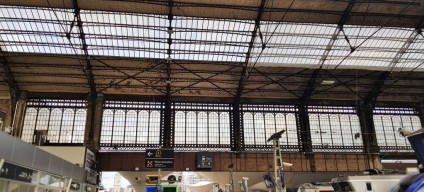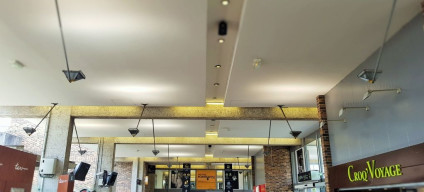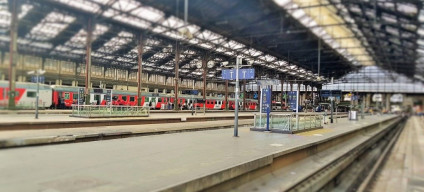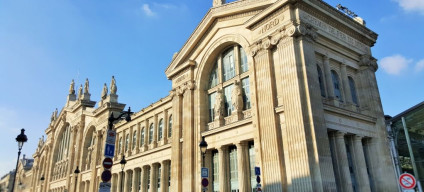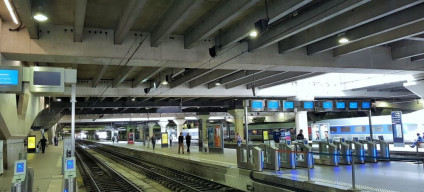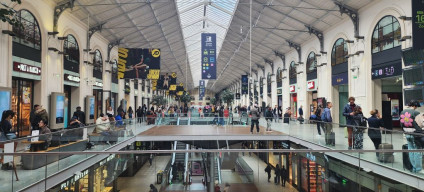Related Content
Content
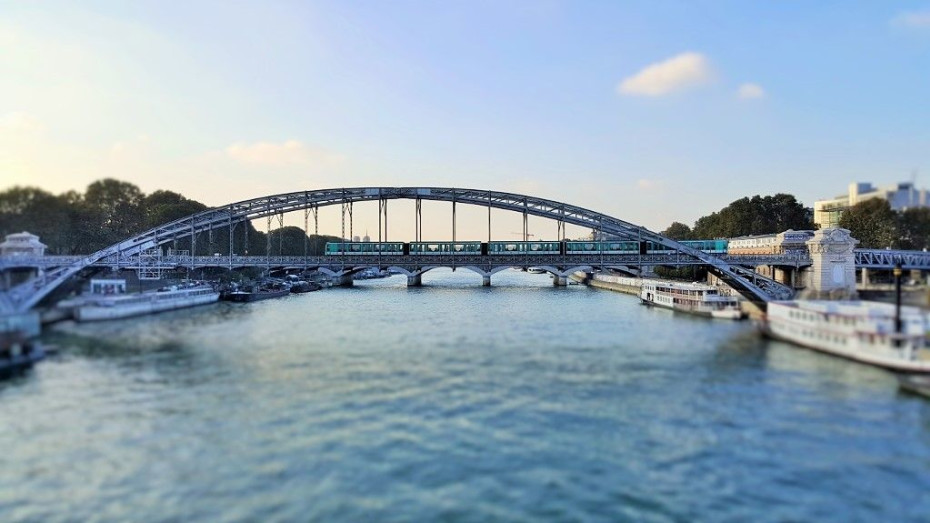
Share
Our guide to arriving and departing from Paris by train includes both tips and info on how to travel between the main stations and the city centre; And also which station you'll need to head to when travelling away from the French capital.
You can click the links contained within the text, to access more info about the trains, journeys and stations, as there's already (ahem) more than enough content on this article - but hopefully it's all highly useful.
If you would like assistance in planning a train journey to or from Paris, or want to include the French capital on a rail travel itinerary, take a look at the Concierge Service.
The 7 main stations:
In common with London, the French capital was already a large city before the advent of the railways, so Paris city centre is ringed by seven train stations
All of these seven stations are terminus stations, meaning that long distance trains to and from Paris, don't travel through the city,
So if your end-to-end train journey involves travelling via Paris, you have to make a transfer between these stations.
Click on their images below to access detailed guides to using each station.
Transfers from and to these stations:
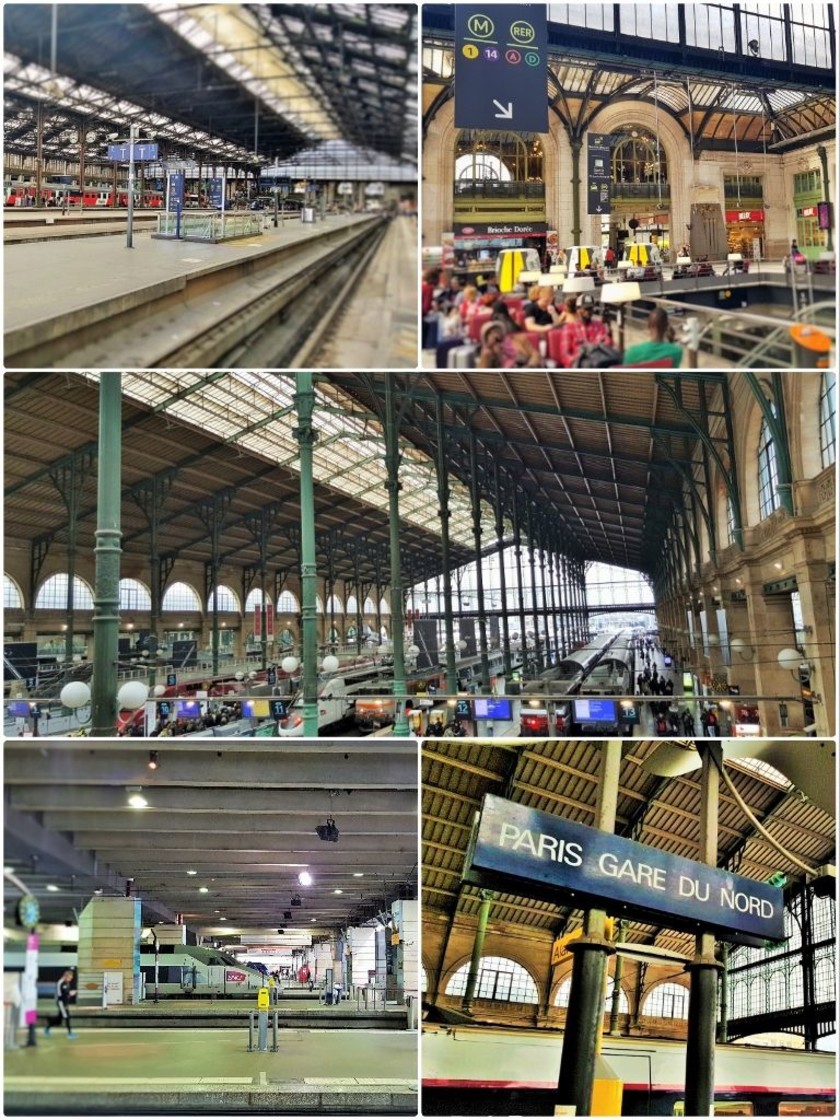
Specific information for how to navigate each major station in Paris when arriving by train is available on our station guides - click on the names of the seven stations above.
Here are our GENERAL tips for using public transport to travel to and from the main Paris stations - no matter which mainline station in Paris your train will be arriving at and departing from.
Taking the Metro when Arriving in Paris:
These three things are worth keeping in mind if you will be travelling on from a mainline station by using the metro:
(1) Work out your route to your final destination in the city before you arrive at the station in Paris.
Metro maps and other route info can be harder to track down at stations than you might expect.
(2 ) Though if you’re going to be spending time in Paris, it can be worth downloading the RATP app to your phone.
RATP manages the public transport network in central Paris and its app has an English language route planning function.
(3) If you're going to be spending a couple of days in Paris on a multi-city itinerary, it can be a good idea to split your luggage, leaving your large, heavy bags in the left luggage office at the station where your train arrives.
Particularly if where you'll be staying in the city, is some distance away - and you will then subsequently be departing from the same station in Paris.
Travelling light on the Metro is the way to go if it's at all feasible.
Using the buses:
When arriving in Paris by train, taking the bus can often be a better option than taking the Metro on to your final destination in the city centre.
- They’re easier to manage if you have luggage, or will be travelling with small children.
- They can take you to areas of the city, which aren’t served by direct Metro lines from the station.
The RATP app can be a big help with showing you at which stops you'll need to board and leave the bus.
Though some bus stops are given the names of stations, despite the fact that they can be a couple of blocks away from them.
The plus points of taking the bus are inevitably negated if the stop is a 5 - 8 min walk from the station and in a location, which isn't particularly obvious - so ShowMeTheJourney has deliberately excluded those stops and routes from those suggested below.
The tickets
You can buy a ticket for a journey in central Paris from the driver when boarding and the cost is €2.50, but you need to pay cash and the exact price is preferred - I tried to buy a fare with a €10 note, but the driver wouldn't accept it and I had to get off.
Or you can purchase a ticket pre-boarding and the standard adult fare is €2.
The two options for that are:
- Using an app; either The Bonjour RATP app or the Île-de-France Mobilités app and then when boarding you tap your phone on the reader.
- loading a journey on to a Navigo card, which can be done at Metro station ticket machines or at some local convenience stores, you then tap the card on the reader when boarding.
However, when using the Navigo cards, you need to purchase and load them with the specific type of bus + tram ticket, so you cannot purchase x number of journeys from a Metro ticket machine.
Without choosing the bus option, those journeys will be for the Metro + RER and when you tap the card reader on the bus, it won't work.
Route/line 91
The bus routes in Paris have just been reorganised and the newly updated Paris bus map is here - though the number of bus routes between the stations and the heart of Paris has been reduced.
Of particular note to rail travellers is that Line/route 91 is now the core inter-station bus service in central Paris.
One end of its route commences at the Gare Du Nord and the other commences at Montparnasse station and in between them it calls at the Gare de l'Est, the Gare De Lyon and Austerlitz.
When heading to the Gare Montparnasse leave the bus at this stop marked 'Gare Montparnasse' - which is two stops before the terminus.
The particularly useful routes for cross Paris rail connections are:
From Austerlitz:
Line 63 to Gare De Lyon from the 'Cour Seine' stop
Line 91 to Montparnasse, from this stop on Boulevard de L'Hopital.
Line 91 to the Gare De Lyon, the Gare de l'Est and the Gare Du Nord from this stop on Boulevard de L'Hopital.
From Paris Est:
Line 32 to St Lazare from one of the stops on the Boulevard de Strasbourg, the square in front of the station (there is no direct Metro line between these two stations)
Line 91 to Montparnasse via the Gare De Lyon and Austerlitz, from a stop on Rue du 8 Mai 1945.
From Paris Lyon:
Line 72 to the Louvre and the Palais Royal from this stop on Rue De Bercy - a good alternative to Metro line 1
Line 91 to the Gare De l'Est and the Gare Du Nord from a stop on Boulevard Diderot
Line 91 to Austerlitz and Montparnasse from a different stop on Boulevard Diderot
From Paris Montparnasse:
Line 91 to Austerlitz, Gare De Lyon, the Gare De Lyon and the Gare Du Nord -
From this stop accessible via Hall 2 - which exits on to the Place de Cinq Martyrs du Lycée Buffon
And from this stop to the left of the small bus station on Boulevard de Vaugirard, over to the left of the main street level exit at the front of the station.
Line 94 to St Lazare from this stop in the small bus station on Boulevard de Vaugirard, over to the left of the main street level exit at the front of the station.
Line 95 to St Lazare from this stop to the left of the small bus station on Boulevard de Vaugirard, over to the left of the main street level exit at the front of the station.
From Paris Nord:
Line 26 and Line 43 to St Lazare from the stop on Rue de Dunkerque, directly outside the station
Line 38 to the Pompidou Centre and Notre Dame from this stop on Rue Du Fauborg Saint-Martin - an alternative to RER Line B
Line 39 to the Palais Royale and Montparnasse from the stop outside the front of the station
Line 45 to Place De La Concorde from the stop on Rue de Dunkerque, directly outside the station
Line 91 to Montparnasse via the Gare De Lyon and Austerlitz from this stop on Rue de Saint-Quentin
From St Lazare:
Line 26 to the Gare Du Nord from the stop on the Cour De Rome, the square outside the frontage of the station, on its right hand side when facing away from the trains
Line 29 to the Gare De Lyon from the stop on Rue St Lazare
Line 32 to the Gare de l’Est from the stop on Rue St Lazare (there is no direct Metro line between these two stations)
Line 94 to Montparnasse from the stop on Rue St Lazare
Using the Paris Metro:
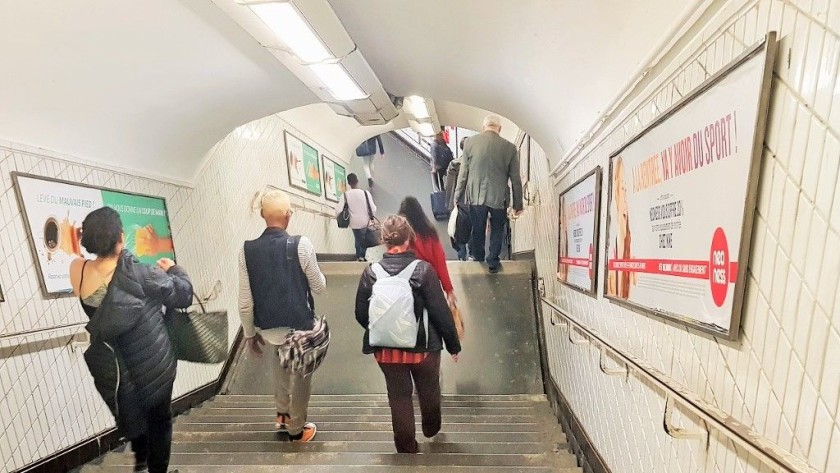
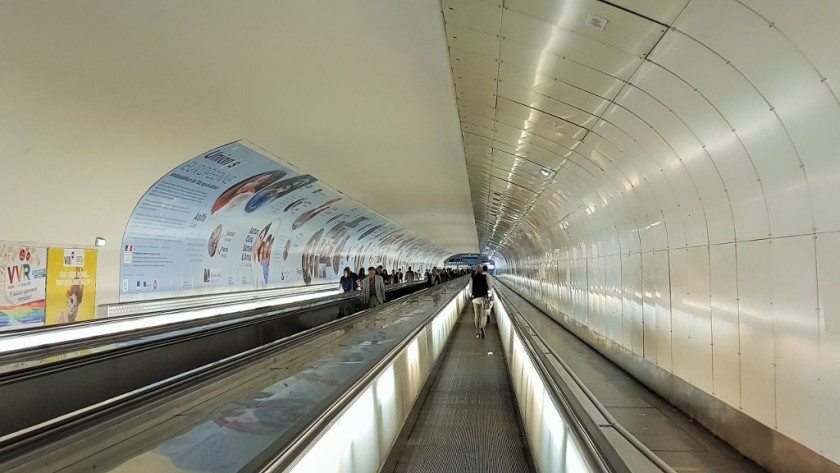
If you don't consider short flights of stairs to be an obstacle, then taking the Metro can be a fast, efficient and relatively cheap means of travelling to and from the stations in Paris.
Here are eleven things worth knowing if you will be using the Paris Metro to travel from or to a mainline station:
(1) Most Paris Metro stations are closely spaced.
If your final destination in the city is only two or three Metro stops from the station your train will have arrived at, it’s likely that it will take less than 15 mins to walk there.
(2) Think twice about using the metro if you have heavy luggage etc, because steps are the only means of transferring between the trains and street at the overwhelming majority of stations.
This includes the transfers between the station concourse and the Metro at some mainline stations.
Paris doesn't have a particularly deep level metro, so most of the staircases you will have to use are fairly short, but they can be a hassle if you’re carrying bags or managing small children etc.
(3) In particular try and avoid journeys which also have TRANSFERS between Metro lines, if you have heavy luggage etc.
Many interchanges between lines will involve having to negotiate multiple sets of steps.
(4) We have tried to track down a list of the few stations that are equipped with escalators, but it has proved elusive.
Partially because the view of Parisians themselves is that there’d be no point in such a list - because the escalators can’t be 100% relied upon.
Though when they are available at a station they're more likely to be working than not.
(5) Ticket gates that can be opened by staff are comparatively rare.
Wider gates that are compatible with large items of luggage can also be tricky to track down.
The normal scenario involves pushing your bags through an opening in the gate-line and then leaving it there while you use a nearby ticket gate.
So you won’t have your hands on your bags at all times – take note if you are a wary traveller and will be travelling alone.
(6) The coaches on metro trains are comparatively small and they don’t have luggage racks etc.
Try to keep your bags away from the doors and putting bags on seats will be frowned on by Parisians; and won’t even be an option at busy times.
Also guaranteed to incur the wrath of Parisians, is sitting on the fold down seats by the doors when the trains are busy.
(7) If it’s feasible, avoid using the metro in rush hours, between 07:45 – 09:45 and between 16:00 and 18:30.
Allow more time if have to travel at these times, you may not be able to board the first or second train to arrive.
(8) In contrast to the older Métro lines, the newer Line 14 has escalators and/or elevators which provide the access between the train and street level and its stations.
So if you will be arriving or departing from the Gare De Lyon, Bercy or St-Lazare, check if taking Line 14 is an option
It’s particularly useful if you will be heading to and from the areas in the city around Pyramides or Madeleine stations.
(9) The destinations of the trains is important, as the signage on the metro uses these stations at the end of the lines, and not north/south etc, to indicate direction.
(10) Some of the Metro stations at the mainline stations can be exceptionally large, so the platforms/tracks that some Metro lines use, can be quite a distance from the entrance to the Metro part of the station.
Meaning that the access from and to the long distance trains, can be comparatively far away from the parts of the station that the Metro lines arrive at and depart from, which leads to long transfers.
Particularly worth knowing is that:
- At Saint-Lazare line 12 is further from the main station than the other lines.
- At the Gare De Lyon the quickest access to and from Metro Line 1 is different to the shortest route to and from line 14.
- At Montparnasse station lines 4 and 12 are much further from the mainline station metro entrance than lines 6 and 13.
(11) You won't usually need to use your ticket to open the ticket gates in order to exit from the platforms, but keep your ticket on you until you have left the station.
Using the RER:
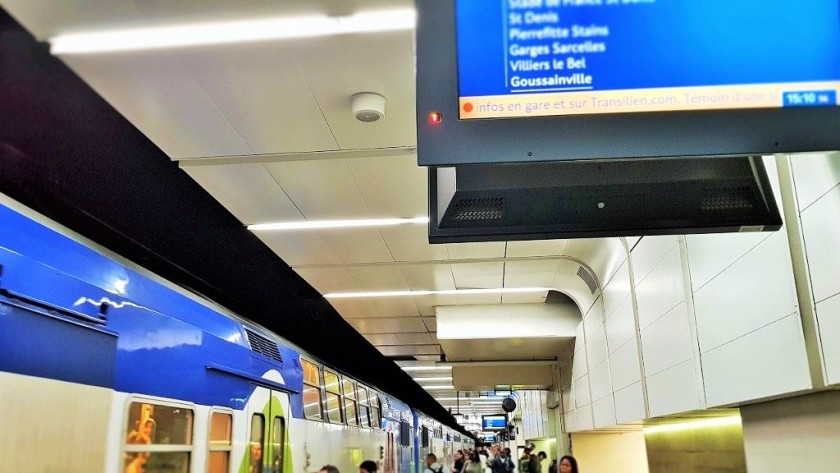
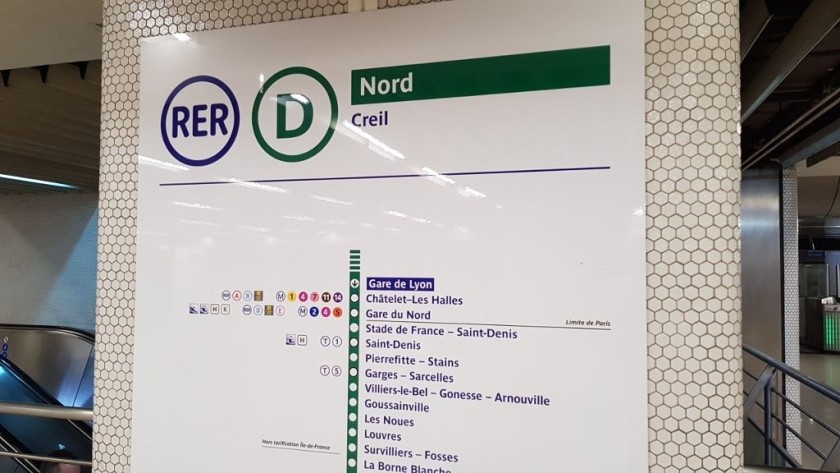
The RER in Paris is a system of main line trains which also cross the city centre in tunnels, so in central Paris these trains are below ground like the Metro.
In the city centre think of them as express Metro lines, as the same central Paris tickets/passes can be used on both the Metro and RER trains.
They can be a better option than taking the metro - they’re faster and are bigger trains, so travelling with luggage etc on them is less of a hassle.
Another big plus is that most city centre RER stations are connected to street level by escalators and/or elevators – though it's best to avoid having to 100% rely on them to give access to and from the trains.
Six other things also worth knowing about the RER:
(1) The only mainline stations in Paris directly connected to the RER are Austerlitz, the Gare De Lyon, the Gare Du Nord and St-Lazare.
(2) If your train will be arriving at or departing from the Gare De Lyon, the RER Line A is a better option than the Metro for reaching many areas of central Paris.
Particularly if your final destination or starting point is near Auber or Charles-De-Gaulle-Étoile stations.
(3) If you will be connecting between the Gare Du Nord and the Left Bank area of the city on the south bank of The Seine, then taking RER line B is a better option than taking the Metro.
Line B stops at St Michel-Notre Dame where connections are also available to RER line C, which stops at the Musée D’Orsay and by the Eiffel Tower.
(4) RER Line C provides the quickest access between Austerlitz stations and locations in central Paris on the south bank of the River Seine.
(5) RER Line D provides the best public transport connection from the Gare Du Nord to the Gare De Lyon and from the Gare De Lyon to the Gare Du Nord.
(6) Taking RER Line E is the easiest means of transferring between the Gare Du Nord and St Lazare.
the ticketing for the Metro and RER
A flat rate rate of €2.50 is charged for virtually any single journey across Zones 1 to 5 by Metro or RER in central Paris, regardless of how many transfers have to be made to complete the trip.
Zones 1 to 5 covers many of the more distant locations including Disneyland Paris and Versailles, but travelling to/from both CDG and Orly Airports cost a special rate of €13.
Though a separate type of ticket is required for travel on the bus and trams.
Also worth knowing is that Paris has pretty much transitioned to a Pay As You Go system named Navigo for its public transport network.
Metro and RER tickets have to be loaded on to physical plastic Navigo Cards, or purchased on one of two apps - the Île-de-France Mobilités app, or the Bonjour RATP app.
If you opt to use the card you can tap it on the ticket gates, but if you opt to use an app, you tap the mobile device on which the app is installed, on the ticket gates.
One card per person, or one app per person.
So Navigo is pretty much the same as how Oyster can be used in London, but unlike London, other forms of Pay As You Go such as bank cards, credit cards and payment apps, cannot be used to access the metro and the RER in Paris.
Using the plastic / physical cards
If you don't want to download one of the apps, see below, there are two types of plastic Navigo Cards:
1: 'Navigo Easy' - These cost €2 and tickets for Zone1-5 journeys can be loaded on to them, or you can purchase a Day Pass and load that on to the card.
Some of the ticket machines on the Metro and RER system will sell the Navigo Easy Cards + the journeys in one transaction, you pay and the machine will issue a card with the journey(s) loaded on to it.
Though most machines only allow pre-purchased Navgio Cards to be inserted and loaded.
Of if a staffed ticket counter is open, you can obtain the Navigo Easy cards + the journeys in one transaction at the counter.
Navigo Easy cards aren't personalised, so if you won't be taking a particular journey or ever returning to Paris, you can hand them on to a friend or family member.
2: 'Navigo Découverte' - These cost €5 and must be purchased at a staffed ticket office, as you also need to take a passport photo to the counter, because it will be used to personalise the card.
A key difference to the Navigo Easy cards is that the Airport tickets for journeys to and from CDG or Orly can be loaded on to a Navigo Découverte' card
For an extended stay in Paris, the Navigo Découverte' cards can also be loaded with weekly or monthly passes (Navigo Semaine, Navigo Mois) - the Navigo Semaine costs approximately €30.75
Hence the total cost, including the Navigo Découverte purchase, is around €36, so if you won't be taking the Metro or the RER from or to the airports, you will need to take more than 14 journeys in Zone 1-5 for this to be worthwhile.
At some busy stations you may see staff on the concourse holding mini payment machines, and when you already have either type of the Navigo card, you can approach these staff and add tickets / journeys to the card.
The excellent parisbytrain website has all the info you will need about metro tickets.
Using the apps
The big plus of the apps is that because you can use mobile banking to pay for transactions the ticket machines and counters at the stations can be avoided.
Post-purchase, you can tap your phone on the card readers on the ticket gates to open them.
Though you need an app / mobile device per person, you cannot purchase tickets / journeys for more than one individual within the app.
However, there are two apps:
1: The Bonjour RATP app keeps things simple, you can use it to buy up to 20 tickets for travel in Zones 1-5.
And the plus of using it is that you don't have to bother with the Navigo Passes, you can buy a ticket(s) and store them within the app.
Plus you can make the purchase(s) in the app before you get to Paris
2: Using the Île-de-France Mobilités app - aka the Navigo Pass app
If you have a compatible iPhone or Apple Watch this app is built into the Apple Wallet
You can add it by tapping the Add (+) button in the Wallet app, selecting "Transit Card," and choosing "Navigo".
Though as explained in depth on this excellent guide, downloading the Île-de-France Mobilités app and setting it up for purchase is a multi-step process if you have an Android device - and the phone needs to be NFC compatible.
However, it seems as though you need to be in Paris before you can make any transactions / payments on the app.
So the best methodology seems to be (1) download/ open the app before you set off, then (2) buy the ticket(s) / passes on the app when you get to Paris.
The key difference to the Bonjour Ratp is that you can use an Île-de-France Mobilités app to purchase a range of passes aka 'titles' in addition to the Zone 1-5 tickets.
These include Day Passes - and if you save a photo in the app, it's also possible to purchase the Navigo Weekly / Navigo Semaine tickets and the Airport tickets.
The excellent parisbytrain website has all the info you will need about metro tickets.
Departing from Paris:
Much of the info above re: using public transport in Paris also applies if you will be heading to a mainline station to take a train from the city.
But there are two other things in particular to look out for, if you use the Metro or RER to arrive at the station your train will be leaving from.
(1) If you will be connecting into a long distance train, follow the signs within the Metro/RER marked ‘Grande Lignes’.
(2) Also check that you’re looking at the electronic departure screens marked ‘Grande Lignes’ - other electronic screens will only show the regional or RER trains.
Click the destination links below for access to guides on how to make these train journeys from Paris.
from Austerlitz
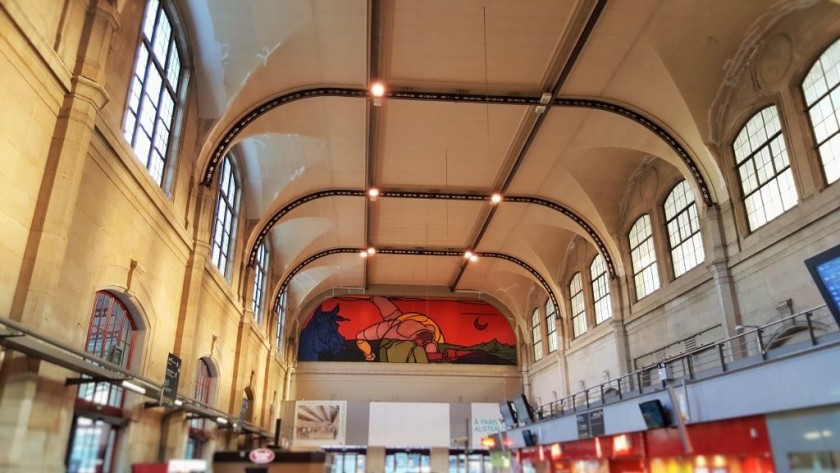
Trains from Paris Austerlitz go to:
Toulouse (by IC trains) l Tours (by TER trains)
Faster TGV trains to Toulouse and Tours depart from Paris Montparnasse; see below.
from Bercy
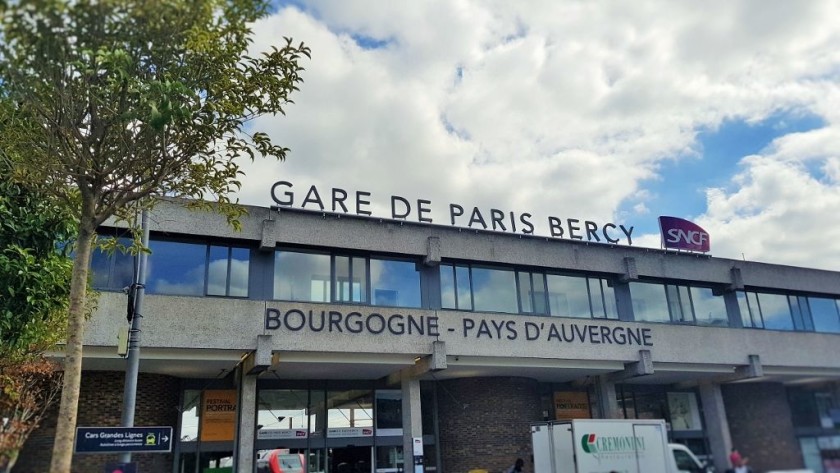
Trains from Paris Bercy Bourgogne - Pays d'Auvergne go to:
Dijon (by TER trains) l Clermont-Ferrand
Lyon (by TER trains) l Nevers l Vichy
Faster TGV trains to Dijon and Lyon depart from the Gare De Lyon - see below.
from Est

Trains from Paris Gare de l’Est go to:
Belfort l Colmar l Frankfurt l Luxembourg
Metz l Munchen l Mulhouse (by IC trains)
Nancy l Reims l Strasbourg
Stuttgart l Troyes
from Lyon
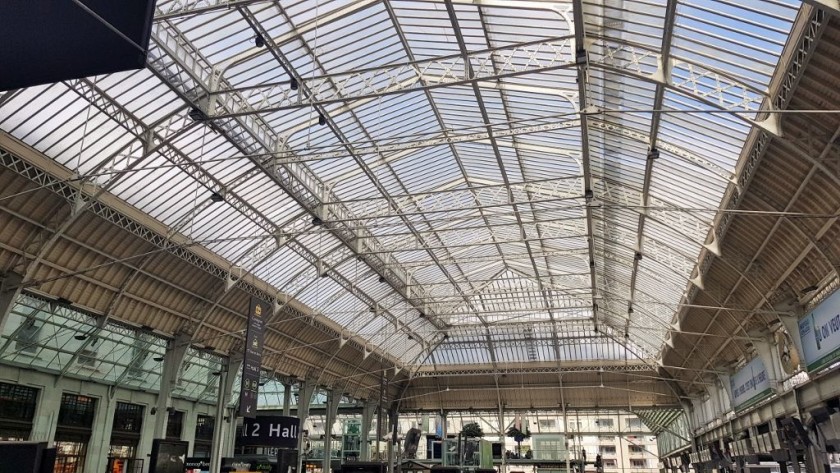
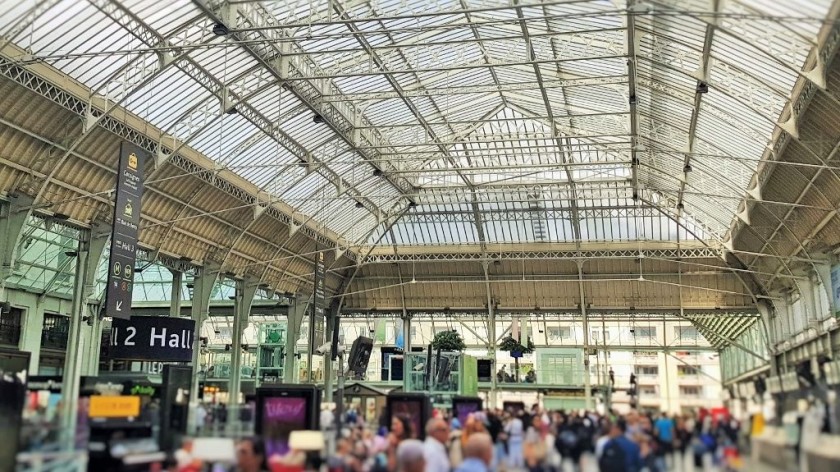
Trains from Paris Gare De Lyon go to:
Aix-en-Provence l Aix-les-Bains l Annecy
Basel/Bale l Bern l Besancon l Béziers
Cannes l Chambery l Dijon (by TGV train)
Lyon (by TGV train) l Marseille l Menton
Milano l Monte-Carlo l Montpellier
Mulhouse (by TGV train) Narbonne l Nice
Nimes l Padova/Padua l Perpignan
St Etienne l Torino/Turin l Toulon
Valence l Venezia/Venice
from Montparnasse
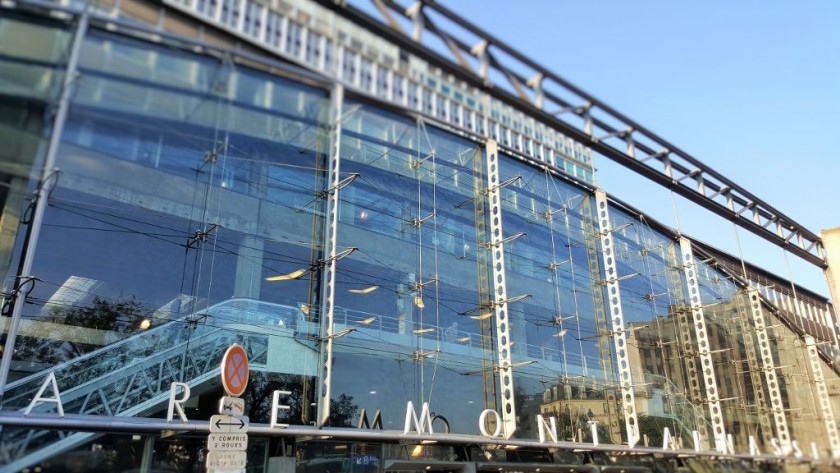
Trains from Paris Montparnasse go to:
Angers l Angouleme l Bayonne l Biarritz
Bordeaux l Brest l Chartres l Futurescope
Hendaye l La Rochelle l Le Mans
Lorient l La Rochelle l Lourdes l Morlaix
Nantes l Poitiers l Quimper l Rennes
St Malo l Tarbes l Toulouse (by TGV train)
Tours (by TGV train)
from Nord
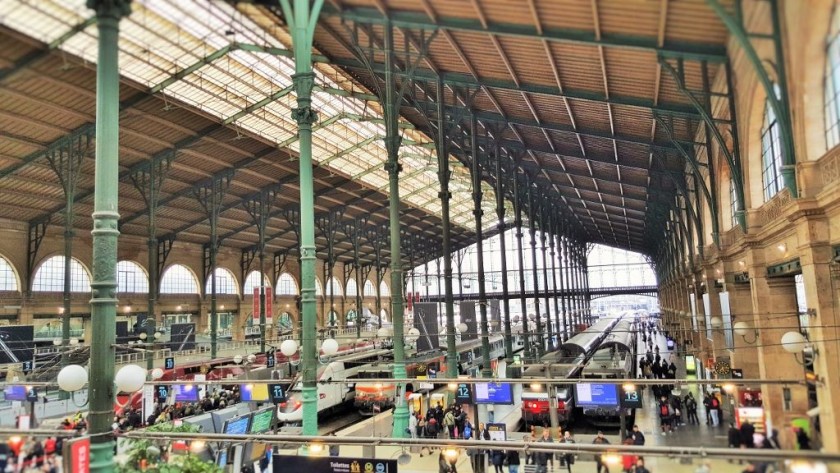
Trains from Paris Gare du Nord (Paris Nord) go to:
Amiens l Amsterdam l Antwerp/Anvers
Beauvais l Boulogne l Bruxelles/Brussels
Dortmund l Koln/Cologne l Lille l Rotterdam
from St Lazare
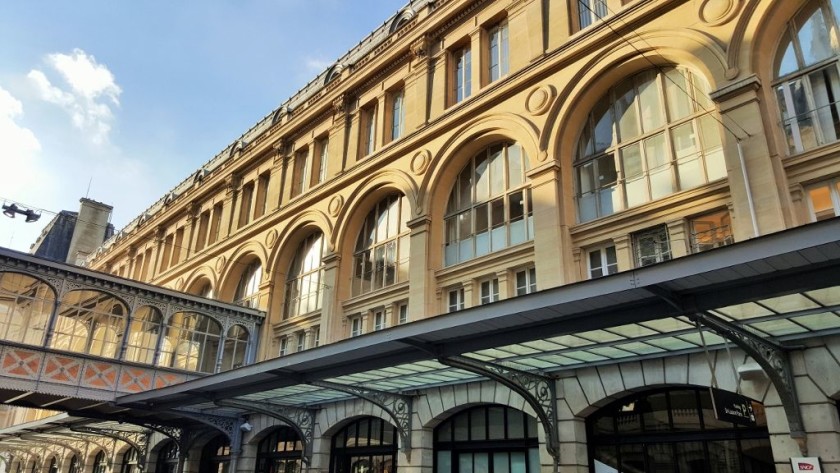
Avoiding the transfer between the main stations:
Having to transfer between stations in Paris, when making an end-to-end journey by train, is a scenario that’s best avoided.
However, what visitors to France can be unaware of, is that it’s often possible to avoid central Paris when travelling in France by train.
From Lille you can take direct TGV trains to:
Aix-en-Provence; Angers; Angouleme; Avignon; Bordeaux; Dijon; Lyon; Marseille; Montpellier; Mulhouse, Nantes; Nimes; Poitiers; Rennes; St Pierre des Corps (Tours); Strasbourg and Valence
The direct train from Lille to Nice via Cannes and Antibes only departs on Fridays.
From Lyon you can take direct TGV trains to:
Bruxelles; Le Havre; Lille; London; Nantes; Rennes and Rouen.
From Nantes and Rennes you can direct TGV trains to Lille, Lyon and Strasbourg
When you have to make the transfer
However, when making a transfer between stations in Paris can’t be avoided, you can find the details of how to take these journeys by Metro and RER these station guides.
Est l Lyon l Montparnasse
Simply click on the name of the station and then scroll down the page you will be taken to
To and from Paris airports by train
In contrast to the likes of London, Rome, Stockholm and Vienna what Paris currently lacks is dedicated express rail links with its primary airports.
Both Paris-Charles de Gaulle and Paris-Orly are connected to the city centre by line B of the RER local train network.
However, the access to/from Charles de Gaulle (CDG) should be transformed from 2027 with the launch of the CDG Express service.
Though a tick in the box for CDG is that it is one of only three European airports to have a station on a high-speed rail line.
At Charles de Gaulle (CDG)
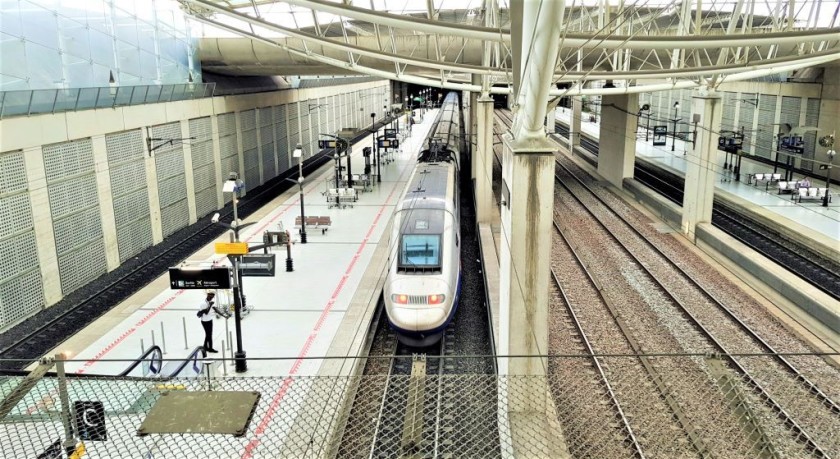
Paris Charles De Gaulle airport has two two stations:
(1) Aéroport Charles de Gaulle 1 station is linked to the Terminal One of the airport by the CDGVal people mover which departs every 4 minutes and has a a journey time of 8 minutes.
The station is also around a 10 min walk from Terminal 3.
Aéroport Charles de Gaulle 1 station is only served by RER trains, but the CDGVal also goes to the station at Terminal 2
(2) Aéroport Charles de Gaulle 2 TGV station which is also known as Charles de Gaulle Etoile.
The station is located in the centre of the massive Terminal 2, and its sub-terminals are linked to the station by a different people mover shuttle system
Route N1 runs every 10-15 mins and provides the link with, sub-terminals A, B, C, D and E; note that sub-terminals A and B are particularly distant from the station.
Route N2 runs every 5 mins and provides the link with terminal 2G.
Within the station the voies (platforms/tracks) used by the RER trains are beside those used by the TGV trains.
Escalators and less obvious lifts / elevators link the station concourse and the voies (platforms/tracks)
Between CDG and central Paris
The rail service between central Paris and Charles-De-Gaulle airport is provided by line B of the RER; which is the system of local trains which cross the city.
The ticket cost is less than €12.
In addition to the Gare Du Nord these line B trains also call at:
- Châtelet–Les Halles - connect for RER Line A; and the station also offers a comparatively easy interchange with Metro line 1; Metro line 4 and Metro line 14; a 10 min walk through the underground passage ways connects line B with Metro line 7 and Metro line 11.
- Saint-Michel Notre-Dame - connect for RER line C
- Luxembourg
- Port Royal
- Denfert-Rochereau - connect for Metro line 4 and Metro line 6.
Eight trains per hour are typically provided, though all day at weekends and during the middle of the day on Monday to Friday, half of the services are faster by around 7 minutes, because they skip some stations.
Though on Monday to Friday:
- when when heading away from the airport before around 08:45 and after around 16:00
- when travelling to the airport before around 09:50 and after around 16:40 on Monday to Friday,
all of the trains call at all of the intermediate stations.
So when heading to the airport on Monday to Friday between 16:40 and 18:40 in particular, the trains in effect become busy commuter services that serve the nine stations between the Gare Du Nord and the airport.
Hence available seats can be hard to find during these times, particularly when boarding at the Gare Du Nord.
The journey time between the airport and the Gare Du Nord, on the northern edge of the city centre, is 31mins by the faster trains and 38 mins by the slower trains.
Note that all of the services are provided by standard RER trains, which happen to be serving the airport. there are no dedicated airport express trains.
So there is a lack of enhanced on board provision such as additional luggage racks or wi-fi, or charging points, though the trains are air-conditioned.
At the airport:
At the times when the fast and slow trains are operating, the fast trains tend to be those which are terminating at Massy-Palaiseau.
Though the fast trains won't overtake the slower services.
From the city centre:
Note that some trains will be heading to Mitry-Claye and these trains don't serve the airport, so take your time and check the destination info, avoid rushing to hop on the next train to depart.
When the faster RER services heading to Charles De Gaulle are available, they tend to depart only three minutes ahead of the trains which call at all of the intermediate stations.
So it's more than likely that the next train to depart will be one of the faster services, but it's best to take the next train regardless, the next faster train won't overtake a slower service.
To and from Orly Airport
Travellers can now choose between taking the Metro or the RER to Orly Airport.
By Metro
Some very welcome news is that Metro line 14 now serves Orly airport with a first train from the airport at around 05:30 and a final train at around 00:30.
The Metro station, which is named, Aéroport d'Orly, is located by Terminals 2 and 3.
So the airport is now directly connected every 2-3 minutes to:
- the Gare De Lyon = journey time of 30 mins; for connections to and from multiple cities including Avignon, Dijon, Lyon, Grenoble and Marseille
- and Paris St-Lazare = journey time of 38 mins; for connections to and from Bayeux, Caen, Cherbourg, Le Havre and Rouen
Other central Paris stops include:
- Madeleine - connect for Metro line 8 and Metro line 12
- Pyramides - connect for Metro line 7
- Châtelet - connect for Metro line 1 and Metro line 4 and Metro line 11
Connections are also available at Châtelet with RER line B and RER line D, so this connection now avoids the need to take the more expensive combination of RER + Orlyval shuttle - see below.
At the Bibliothèque François-Mitterrand station station a transfer is available with RER line C which serves multiple stations on the Left/South bank of The Seine in central Paris including:
By RER Line B
A people mover system named Orlyval links the airport terminals with Antony station.
This station is on line B of the RER; which is the system of local trains which cross the city.
The journey time on the Orlyval is around 9mins between Antony and the stop which serves Terminal 4.
The transfer between the airport and the stop which serves airport terminals 1, 2 and 3 is around 6 minutes.
Though terminals 2 and 3 are some distance from the access with the Orlyval; terminal 3 is at the opposite end of the main terminal building.
Tickets for the ride to/from Antony cost more than €9 and tickets which combine the Orlyval and the RER are also available.
Though the final Orlyval shuttle of the day to Antony typically departs the airport at around 11:30.
When heading to the airport take care to avoid the trains heading to Robinson!
To the city centre by RER:
Seven trains per hour typically depart from Antony to the city centre.
The trains heading to Charles De Gaulle airport during the middle of the day on Monday to Friday and at weekends, are faster by around 6 mins because they skip some stops.
Note that RER line B connects Antony to the stations at Charles de Gaulle (CDG) airport, allow 1hr 15mins to make the end-to-end transfer between the airport terminals at Orly and CDG.
In the city centre the trains call at:
- Denfert-Rochereau - connect for Metro line 4 and Metro line 6.
- Port Royal
- Luxembourg
- Saint-Michel Notre-Dame - connect for RER line C but there is alternative access to line C by taking the tram from/to the airport - see below.
- Châtelet–Les Halles - connect for RER Line A; and the station also offers a comparatively easy interchange with Metro line 1; Metro line 4 and Metro line 14; a 10 min walk through the underground passage ways connects line B with Metro line 7 and Metro line 11.
- Gare Du Nord
The journey time between Antony and Châtelet–Les Halles is 21 - 26 minutes.
To sporting and exhibition venues from the major Paris stations
How to travel on to the major sports , entertainment and business venues in Paris from the major stations.
the Stade De France
The Stade de France is located more than 3km from the city centre, so walking to the stadium from the Gare Du Nord will take at least an hour.
Three railway stations are much closer to the stadium:
1 - Stade De France – Saint Denis station
2 - La Plaine Stade de France station
3 - Saint Denis-Porte De Paris station
Though which of them will be the most convenient will depend on the starting point of your journey and where you will be sitting.
If your seats are in blocks are on the south and east sides of the stadium, the station named La Plaine Stade de France on RER line B has the shortest walking distance of around 10 to 15 minutes
If you will be sitting on the western side of the stadium the shortest and easiest walking route is from the station named Stade De France – Saint Denis on RER line D, despite it being the farthest of the three stations from the stadium.
Though bus line/route 353 is a five stop ride to the stadium and its stop is by blocks U, X and Y.
On the northern side of the stadium the Metro stop named Saint Denis-Porte De Paris is closest - it is actually the nearest of the three stations to the stadium.
To the Stade By France by RER train
In addition to the metro Paris is crossed by network of local trains known as the RER and in the heart of the city, tickets and local passes are interchangeable with the Metro.
La Plaine Stade de France station is served by RER Line B and Stade De France – Saint Denis station is on RER Line D.
Line B is also direct to and from CDG Airport and it has a station named Antony, which is connected to Orly Airport by a people-mover, the Orlyval.
To the Stade By France by Metro train
Saint Denis-Porte De Paris is on one of the two northern branches of Metro Line 13, so take care to board trains heading to Saint Denis-Université.
Though Line 13 is the busiest of all those on the Paris Metro so an alternative route to Saint Denis-Porte De Paris is:
1 - take a RER Line D train to the station named Saint Denis, it is one stop beyond Stade De France – Saint Denis.
2 -Tram line T8 goes from this station to Saint Denis-Porte De Paris, the tram stop is straight ahead from the station exit, on the other side of a bridge which spans a canal.
Though note that taking Metro Line 13 won’t be an option when attending the Paralympic Events at the Stade De France.
To the Stade By France from the main stations in Paris
Though which of the stations by the Stade De France offers the easiest access, will also depend on which of the main stations in Paris that you will heading from.
From Gare du Nord:
The RER trains on line B and line D will depart from opposite sides of the same platform (RER Nord) - So be guided by where your seats are located and take which line will give you the easiest access.
Both lines will have trains departing every 5 to 10 mins
If you are seats are on the northern side of the stadium in blocks C, D, E. G, H and J, the easiest option, will be to take a combination of the line D to Saint Denis station and then transfer to tram line T8 on to Saint Denis-Porte De Paris (see above)
From Gare de Lyon
RER line D is direct to Stade De France – Saint Denis station, so you can leave the train there and walk or take a bus or tram.
OR remain on the train one stop beyond to the station confusingly named St Denis and transfer to Tram line T8 – see above.
Which is of these two options will be better depends on which block in the stadium which you will be sitting - see above.
From Montparnasse
Take Metro Line 13 direct to Saint Denis-Porte De Paris, OR take Metro line 6 to Denfert Rocherau and transfer there to a Line B train to La Plaine Stade de France station.
From Gare de l’Est
Take Metro Line 5 to Gare Du Nord to connect with RER Lines B and D (see the advice for reaching the stadium from the Gare Du Nord)
OR avoid the crowds and take this longer roundabout route
1 – Take Metro Line 7 to its northern terminus at La Courneuve–8 mai 1945
2 – Take Tram route / line T1 to Basilique de Saint-Denis
3 – Take Metro line 13 for a one stop hop to Saint Denis-Porte De Paris
From St Lazare:
Take Metro Line 13 direct to Saint Denis-Porte De Paris, OR
1 - take RER line E to Magenta station
2 – Make the short transfer to Gare Du Nord
3 – Take RER lines B or D, see the Gare Du Nord info above.
From Austerlitz:
Take RER line C to St Michel-Notre Dame station and transfer there to a Line B train to La Plaine Stade de France station.
the Accor / Bercy Arena
The Accor Arena is located across the street from Paris Bercy Bourgogne-Pays d'Auvergne station.
It is also within a 20 minute walk from both the Gare de Lyon and Austerlitz.
From Gare du Nord:
Take RER Line D to the Gare de Lyon - and from there either walk or transfer to Metro Line 14 for a one stop hop to Bercy metro station.
From Montparnasse:
Take Metro Line 6 direct to Bercy metro station.
From Gare de l’Est:
Take Metro Line 7 to Pyramides station and connect there for a Line 14 train to Bercy metro station.
From St Lazare:
Go direct on Metro line 14 to Bercy metro station.
to the Villepinte Exhibition Centre
The Villepinte Exhibition Centre is located on the northern edge of Paris by CDG Airport.
The station which serves the Exhibition Centre is named Parc des Expositions, and it is a one or two stop hop from the airport by trains on RER line B.
When travelling from central Paris you will need to board a line B train heading to Aeroport Charles De Gaulle, but during the day not all of these trains will call at Parc des Expositions, so take care when boarding.
From Gare du Nord:
Take RER Line B direct to Parc des Expositions station
From Gare de Lyon:
Take RER Line D to Gare Du Nord and make a simple cross-platform interchange to the Line B on to Parc des Expositions station
From Montparnasse:
Take Metro line 6 to Denfert Rocherau and transfer there to a Line B train to Parc des Expositions station
From Gare de l’Est:
Take Metro Line 5 to Gare Du Nord and transfer there to a Line B train to Parc des Expositions station
From St Lazare:
1 - Take RER line E to Magenta station
2 – Make the short transfer to Gare Du Nord
3 – Take RER line B to Parc des Expositions station
From Austerlitz:
Take RER line C to St Michel-Notre Dame station and transfer there to a Line B train to Parc des Expositions station
to the Addidas / Porte de la Chapelle Arena
Tram line / route T3b stops a couple of minutes walk from the venue - which is typically named the Adidas Arena.
From Gare du Nord:
It is a two step journey:
- Use the passage way in the station to access Magenta station and take the RER line E to Rosa Parks station
- Transfer to tram line / route T3b and leave it at the Porte de la Chapelle stop.
From Gare de Lyon:
It is a two step journey:
- take Metro line 14 to Porte de Clichy
- Transfer to tram line / route T3b and leave it at the Porte de la Chapelle stop
From Montparnasse:
Go direct on Metro line 12 to Port de la Chapelle station
From Gare de l’Est:
It is a two step journey:
- take Metro line 7 to Porte de la Villette
- Transfer to tram line / route T3b and leave it at the Porte de la Chapelle stop
From St Lazare:
Go direct on Metro line 12 to Port de la Chapelle station
From Austerlitz:
It is a two step journey:
- take RER trains on Line C to Porte de Clichy (board trains heading to Pointoise)
- Transfer to tram line / route T3b and leave it at the Porte de la Chapelle stop.
to Stade Garros
The iconic tennis venue is located within easy walking distance of two metro stations:
- Porte d’Auteuil on Metro line 10 from central Paris
- Michel-Ange Molitor which is on Metro line 9 and is used by Metro line 10 trains heading towards central Paris.
From Gare du Nord:
- Take a Metro line 4 train to Strasbourg St Denis
- Take a Metro line 9 to Michel-Ange Molitor station
From Gare de Lyon:
- Take a Metro line 1 train to Franklin D, Roosevelt
- Take a Metro line 9 to Michel-Ange Molitor station
From Montparnasse:
It is a two step journey:
- take Metro line 6 to La Motte - Picquet Grenelle station
- Transfer to Metro line 10 and leave it at Porte d’Auteuil station
From Gare de l’Est:
It is a two step journey:
- Take a Metro line 4 train to Strasbourg St Denis
- Take a Metro line 9 to Michel-Ange Molitor station
From St Lazare:
It is a two step journey:
- Take a Metro line 13 train to Miromesnil station
- Take a Metro line 9 to Michel-Ange Molitor station
From Austerlitz:
Either
Take Metro line 10 direct to Porte d’Auteuil station station.
to Paris Expo Exhibition centre
The Paris Expo Exhibition Centre is located in the south west corner of the city.
(Note that despite the name of the surrounding area, this venue is not located in Versailles).
From Gare du Nord:
It is a two step journey:
- take RER line B (Sud) to Cité Universitaire station
- take tram route / line 3a to its stop at Porte de Versailles
From Gare de Lyon:
It is a two step journey:
- take Metro line 14 to Madeleine station
- take Metro line 12 to Porte de Versaille station
From Montparnasse:
Go direct on Metro line 12 to Porte de Versaille station
From Gare de l’Est:
It is a two step journey:
- take Metro line 4 to Montparnasse - Bienvenüe station
- take Metro line 12 to Porte de Versaille station
From St Lazare:
Go direct on Metro line 12 to Porte de Versaille station
From Austerlitz:
It is a two step journey:
- take Metro line 10 to Sevres - Babylone station
- take Metro line 12 to Porte de Versaille station
the Parc de Princes and the Stade Jean-Bouin
The Parc de Princes and the Stade Jean-Bouin are adjacent to each other in the Boulogne-Billancourt area of the city - which is served by Metro Line 9 and Metro Line 10.
The closest station on Line 9 is Porte de Saint-Cloud, but by the stadiums, the Line 10 splits - so its closest westbound station is Porte d’Auteuil, but the trains heading eastv back into the city, go from the station named Michel-Ange Molitor.
From Gare du Nord:
- Take a Metro line 4 train to Strasbourg St Denis
- Take a Metro line 9 to Porte de Saint-Cloud
From Gare de Lyon:
- Take a Metro line 1 train to Franklin D, Roosevelt
- Take a Metro line 9 to Porte de Saint-Cloud
From Montparnasse:
It is a two step journey:
- take Metro line 6 to La Motte - Picquet Grenelle station
- Transfer to Metro line 10 and leave it at Porte d’Auteuil station
From Gare de l’Est:
It is a two step journey:
- Take a Metro line 4 train to Strasbourg St Denis
- Take a Metro line 9 to Porte de Saint-Cloud
From St Lazare:
It is a two step journey:
- Take a Metro line 13 train to Miromesnil station
- Take a Metro line 9 to Porte de Saint-Cloud
From Austerlitz:
Either
Take Metro line 10 direct to Porte d’Auteuil station station.
Please support ShowMeTheJourney
This second version of ShowMeTheJourney is exciting and new, so we are genuinely thrilled that you are here and reading this, but we also need your help.
We’re striving not to let anything get in the way of providing the most useful service possible, hence a facility has been set up with DonorBox which can be used to support the running costs and make improvements.
Instead of advertising or paywalls, your financial support will make a positive difference to delivering an enhanced service, as there’s a lot of ideas which we want to make happen.
So if you have found the info provided here to be useful, please go here to say thank you.
14 day trips from Paris:
Paris also makes for a great base for exploring northern France by Train.
We’ve ranked these day trip ideas by journey time from the station in Paris, in which you’ll be commencing your journey.
Click the name of the destination for access to online guides to each location
When they're available, click the Read More buttons to access a guide to making this train journey.
Book tickets online in advance to save money on the journeys we have marked with (*).
Though to save money, you will have to select specific trains for you outward and return journeys.
For journeys which don't have that symbol, you can buy tickets last minute at the station, without any financial penalty or journey constraints – and take any train back to Paris.
to Fontainbleu
To Fontainbleu; 43 mins from the Gare De Lyon.
You will be taking a local* or TER train to Fontainebleau-Avon station, where a shuttle bus to the chateaux will meet the trains
Visite Paris cards are valid on these trains and they can also be used on the bus, but if you don’t have a card, the bus ticket will cost €2.
Between 09:00 and 13:00 trains to Fontainebleau-Avon depart from Hall 1 in the Gare De Lyon every 30 mins.
The final destination of the train will usually be Montargis, Monterau or Laroche-Migennes.
*For some reason the train numbers for these local trains to Fontainebleau-Avon begin with ‘RER’, but these are not typical RER trains.
They don’t cross Paris, and you won’t find Fontainebleau-Avon station on the RER route map and at the Gare De Lyon they don’t depart from the part of the station, which the other RER trains use.
to Reims*
Reims in 45 mins from the Gare de l’Est.
to Versailles
Versailles in 45-50 mins from St Michel-Notre Dame station
To visit the palace you need to take a train on RER Line C route C5 to Versailles-Château-Rive-Gauche station, which is a terminus station.
So on the departure screens check that the train will be heading to this specific station.
Versailles-Château-Rive-Gauche station is a 13 min walk from the entrance to the Versailles Palace complex.
These trains on line RER C also makes stops at these stations in central Paris – Invalides; Musée D’Orsay and Champs de Mars-Tour Eiffel.
They also call at Paris Austerlitz main line station.
Trains to Versailles-Château-Rive-Gauche depart every 15 or 20 mins, but take care that you don’t board a train to Versailles-Chantiers – that station is in Versailles town centre.
Visite Paris cards are valid on these trains.
to Disneyland Paris
Disneyland Paris in 48 mins from Chatelet Les-Halles station
You need to take a train on RER Line A route A4 to Marne-la-Vallée Chessy station, which is located across the street from the entrance to the park.
These trains on RER Line A route A4 also make stops at these other stations in central Paris; Charles-de-Gaulle Étoile and Auber.
They also call at Paris Lyon.
Trains to Marne-la-Vallée Chessy station depart at least every 12 mins, though take care NOT to board trains heading for Boissy-Saint-Leger.
Visite Paris cards are valid on these trains.
to Orléans
Orléans in around 1hr from Austerlitz station.
to Giverny
Giverny in around 1hr 15 mins from St-Lazare station
There are two train services available from Paris St-Lazare to ‘Vernon-Giverny’ station; faster TER trains which complete the journey in around 50 mins and 'Transilien' commuter trains on line J which take more than 90 minutes.
The Transilien trains depart every other hour during the day, but although the TER trains are less regular, overall they provide the more frequent service, but they don't depart in every hour either.
So it's a good idea to look up the departure times before heading to St-Lazare, in some hours there are no trains at all.
Something to watch out for is that the TER trains, which will be heading to Rouen, tend to depart around 20-25 mins after the Transilien trains, but they actually arrive in Vernon-Giverny sooner.
The Transilien trains stand out on the departure screens as they will be terminating at Vernon-Giverny, so they seem to be easier option.
On arrival at Vernon-Giverny, you will need to take the bus that is scheduled to meet the TER trains.
The 1hr 15min journey time includes the train journey and the bus transfer.
Your train ticket won’t include the bus ride and you can buy tickets from the driver, the return trip from and to the station will cost around €6.50.
to Chartres
Chartres in around 1hr – 1hr 15mins mins from the Gare Montaparnasse.
to Amiens*
Amiens in around 1hr – 1hr 15mins mins from the Gare Du Nord.
to Lille*
Lille in around 1hr 10mins mins from Paris Gare Du Nord.
How to travel by train from Paris to Lille
to Rouen*
Rouen in around 1hr 10mins – 1hr 25 mins from Paris St-Lazare.
There are fewer fast trains between Paris and Rouen on Sundays.
to Tours*
Tours in 1hr 12 min – 1hr 30 mins from Paris Montparnasse.
to Beauvais
Beauvais in around 1hr 15mins from the Gare Du Nord.
to Futurescope*
Futurescope in around 1hr 50mins from Paris Montparnasse.
to Mont St Michel*
Mont St Michel in around 3hr – 3hr 15 mins* from Paris Montparnasse.
*The journey time includes the bus transfer from Rennes station to Mont St Michel.
There are two different routes if you want to travel by train + bus from Paris to Mont St Michel (1) via Dole and (2) the route we have singled out via Rennes.
We suggest travelling via Rennes because:
- it’s usually cheaper, particularly when booking in advance;
- the connections are more frequent;
- the end-to-end journey will be around 15 mins faster.
For the inside track on how to take many of these day trip suggestions, we highly recommend taking a look at this great guide on Savvy Backpacker.

Simon Harper
I wanted to share my passion for train travel and explain how anyone can take the fantastic journeys I have taken.

This is one of more than 100 train travel guides available on ShowMeTheJourney, which will make it easier to take the train journeys you want or need to make. As always, all images were captured on trips taken by ShowMeTheJourney.
This second version of ShowMeTheJourney is exciting and new, so we are genuinely thrilled that you are here and reading this, but we also need your help.
We’re striving not to let anything get in the way of providing the most useful service possible, hence a facility has been set up with DonorBox which can be used to support the running costs and make improvements.
Instead of advertising or paywalls, your financial support will make a positive difference to delivering an enhanced service, as there’s a lot of ideas which we want to make happen.
So if you have found the info provided here to be useful, please consider saying thank you.
